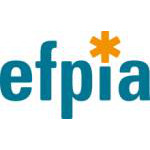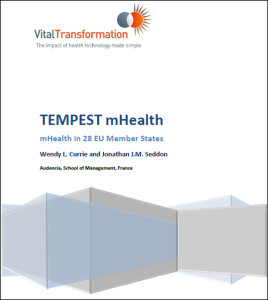| Authors: | |
  |
|
| Wendy L. Currie and Jonathan J.M. Seddon Audencia, School of Management, France |
This research was supported by:
 |
 |
 |
I. Executive Summary
One of the biggest health care challenges in the coming years is how technology can be used to improve health service delivery. With the steadily increasing average life expectancy across all of Europe expected to be over 80 by 2025 and 82.5 by 2050, (see Fig 1), new and improved processes need to be delivered to meet future health requirements. As shown by the slope of the trend lines for each of these years, those countries that have lower values now will see the largest increases to average life expectancy.

Figure 1: Average life expectancy across EU-28 for 2013 and predicted ages in 2025 and 2050
Source: http://www.geoba.se/index.php
European health systems are under pressure to change health service delivery, by developing new business models to reduce cost and streamline services. For example, in the UK, a recent article in the Financial Times (FT) said “the NHS will have to find billions to build and run more than 20 new hospitals by early in the next decade unless it can find ways to treat more patients in the community or their own homes…if admissions continue to rise, an aging population will require 22 new hospitals by 2022”
[1]. UK spending on health is set to rise from 26% in 2000-1 to 35% by 2018 [2]. One solution is for the integration of mobile technologies with hospital services and patient data, underpinned by changes to each government’s digital strategies and increased telecommunications investment. The digital divide that exists between many European countries presents additional challenges to each country that need to be resolved before the benefits offered by mobile health (mHealth) can be realised.
- There are over 100,000 mHealth apps but only 100 have FDA approval
- Hospital beds are decreasing across all of Europe, and this trend looks set to continue
- A quarter of all internet traffic comes from mobile devices
- Mobile traffic is decreased amongst those countries with higher mobile rates
- Accessing the internet for health information is increasing across all European country
- The frequency of making online appointments is different across all of Europe
- Seeking online information about health via a mobile phone has not increased equally across EU-28
- No real obstacles to using mobile technology are perceived to existing within each European country
It is not just the patient that would benefit by an integrated mobile service. Mobile application services can be used to reduce care costs and improve the workflow for doctors and nurses. Managing how a patient interacts with the hospital, automatic event triggering for patient teams and personalised mobile experiences will all help to shape and improved a patient care and experience [16]. And it’s not just during a patient visit that services are improved using mobile technology. Analysis by the Nuffield trust has “underlined the importance by reducing admissions, but also ensuring that those admitted return home as quickly as they safely can” [2]. Figures released for a telemedicine service that was setup after discovering that 3% of local patients used 39% of NHS resources, showed that in 2012-13 there was a 35% reduction in hospital admission and a 58% reduction in ‘bed days’. Mobile technology is clearly an important element in helping to reduce costs as people live longer.
1. Introduction
Between 2011 and 2039, non-communicable diseases such as diabetes, heart disease, cancer and dementia will cost the global economy an estimated $47tn in lost output [3]. Forecasts from Alzheimer ’s Disease International predict an increase of almost 100m dementia sufferers by 2050 [4]. There is a clear challenge in the development of healthcare strategies around the world where organisations have had to become more patient centred, efficient and cost coordinated. Patient outcomes and costs have never been so important, fuelled by the growth of healthcare consumerism. It is only through the consolidation of health systems that the ultimate goal of increased access to health records and patient information can be realised. Data storage in the cloud allows costs to be incremental rather than up-front expenditures, enabling expertise and performance to be outsourced. Access to data, hospitals, medical consultants as well as a tightly integrated health service across the web has been made available to mobile devices. The number of mobile health (mHealth) apps downloads and users almost doubles every year [5], looking to benefit from the 100,000 mHealth apps which are currently available across multiple platforms. It is interesting that only 100 of these have gained FDA approval.
MHealth is defined as “medical and public health practice supported by mobile devices such as mobile phones, patient monitoring devices, personal digital assistants (PDAs) and other devices” [6]. Worldwide mobile health revenue is expected to reach about $23 billion across all stakeholders (mobile operators, device vendors, healthcare providers and content/application players) by 2017 (PWC/GSMA, 2012), with Europe valued at $6.9bn. One estimate is that by 2018, there could be 1.7 bn mHealth users worldwide [7]. As the increase in mobile phone subscriptions continue, coupled with the development of mHealth applications, this paper examines how the 28 European countries are increasing their use of mobile devices and how health web based health information is being accessed.
The data that has been collected forms part of the TEMPEST[i] database project which began in 2009. This is focused around the 28 EU member states and provides comparative data for both statistical and analytical research. These quantitative indicators are sourced from multiple reputable data sources (WHO, EC, World Bank) and offer benchmark performance on technology, economic, market, political, evaluation, social and technical metrics. This information allows policy-makers to make better informed decisions about the intersection between health and technology factors.
1. a. Health within Europe
Between 2003 and 2013, the average life expectancy across Europe has increased from 77.2 to 78.4 years. Whilst values for countries such as and Latvia (73.2), Estonia (73.8) and Bulgaria (74) are all increasing, they are still over seven years below those of Spain (81.4), France (81.4) and Italy(82). The Figure 3 shows the life expectancy and GDP per capita from 2013.
Gross domestic product (GDP), as defined by Eurostat, is a measure for each country’s economic activity. It represents “… the value of all goods and services produced less the value of any goods or services used in their creation. The volume index of GDP per capita in Purchasing Power Standards (PPS) is expressed in relation to the European Union (EU28) average set to equal 100.” Comparing this GDP figure against life expectancy suggests there is a direct relationship here. If the less well developed European countries are planning how they can best serve their growing and aging population, mHealth needs to be at the forefront of their plans.
The latest figures available from Eurostat [8] show that the total number of available hospital beds within Europe was estimated at 2.7 million. This is a reduction of almost 11% on the figures from ten years earlier and represents a general decrease across Europe. Healthcare resources can also be seen as being concentrated in the highest populated regions. The ability of being able to access medical information and health care applications is clearly a service that would benefit not just those who live in areas that have more developed health services. There are many elements that need to be in place if this is to be realised: government investment in web services, location independent telecommunications services, affordable access, integrated health infrastructures, user awareness and a confidence in the services that are used. This paper reviews the availability of mobile phones across Europe and looks at their use to access health data.
2. Mobile phone contracts within Europe
Globally, a quarter of internet traffic now comes from mobile devices, with smart phone subscribers now accounting for 30% of all mobile phone users [9]. The share of fixed-line voice operations has shrunk as the expansion within telecommunications has grown around data and mobile markets. Within Europe, the delivery and adoption of mobile phones has been phenomenal over the past twelve years. In 2000, the five countries that had the highest numbers of subscribers were Germany, United Kingdom, Italy, France and Spain accounting for almost 72% of the 260 million European subscriptions. Germany alone had over 18% of this total figure (some 48m subscriptions). By 2012, Spain had been replaced by Poland as having the fifth highest number of subscribers, but this group of five countries now only accounted for 62% of the 630 million subscriptions. Italy now had the largest number of mobile subscriptions with 97m (15.3% of the total), compared to Germany’s 92m (14.6% of the total).The bar charts in Figure 001x shows the number of mobile phone subscriptions for each country in 2012 beside the population of that country in 2011, ordered by the percentage of subscriptions per 100 inhabitants in 2012.

Figure 4: Number of mobile phone contracts, population and subscriptions per 100 inhabitants – Source: UN data – https://data.un.org/Data.aspx?d=ITU&f=ind1Code%3AI911, World Development Indicators 2013
By 2012, only two countries had less than 100% mobile subscriptions per 100 inhabitants – Cyprus (with a population of 1.1m was at 98.4%) and France (with a population of 65m was at 97.4%). This can be seen visually in Figure 4, where a county’s first bar chart column is lower than the second. Population size is not the main influencing factor on the number of mobile phone subscriptions. Although Finland, Lithuania, Austria and Estonia have the highest values for subscriptions per 100 inhabitants, Italy, Poland and the UK are themselves ahead of sixteen much smaller populations.
In 2002, Luxembourg was the first of the European countries to have exceeded 100% mobile subscriptions per 100 inhabitants. By 2006 all of the largest European countries had met or exceeded this value (Italy in 2004, UK in 2005 and, Germany and Spain in 2006). The year each country hit at least 100%, together with their number of subscriptions by 2012 is shown in Figure 5.

Figure 5: Year European countries exceeded 100% mobile-cellular telephone subscriptions per 100 inhabitants and the percentage of subscriptions by 2012 Source: UN data – https://data.un.org/Data.aspx?d=ITU&f=ind1Code%3AI911
As expected, Figure 5 shows that for the majority of countries those that had the earliest adoption of mobile services, by 2012 had the highest percentage per 100 inhabitants. Countries which buck this trend are Ireland (which hit 100% in 2005 but by 2012 had the fifth lowest value) and Poland which had the eight highest score but only exceeded 100% in 2007.
It is interesting to note that not every country has simply increased the number of mobile phone subscriptions year on year. The 2012 values showed that half of the European countries had actually decreased their value from an earlier peak. Figure 6 shows when each country had its highest number of subscriptions, and the percentage difference between that year and the 2012 value. For example Austria’s highest total was in 2012 (hence 0% change against peak year) whilst Portugal peaked in 2008 but by 2012, had over 12% fewer mobile subscriptions.

Figure 6: The year each European country had its highest number of mobile subscriptions and the difference between this value and that in 2012 – Source: UN data – https://data.un.org/Data.aspx?d=ITU&f=ind1Code%3AI911
2. a. Proliferation of mobile phone operators and network coverage
Figure 7 shows the number of nationwide licensed mobile cellular service providers that have their own network infrastructure (as opposed to other mobile service providers who lease it, for example, Mobile Virtual Network Operators) together with the country’s area.

Figure 7: Number of mobile phone operators in 2010 and country area – Source: IC4D-2012-Report and World Development Indicators 2013
With the exception of Cyprus (third smallest country by area), over half of the European countries have three mobile phone operators. Only Poland has five. Of those with three operators, Finland and France might be expected to have more operators, based upon their size. Slovenia, Denmark, Ireland and Austria are countries that have four operators but are considerably smaller than all of the other countries in this group, but as a general rule, the number of operators matches the countries area. Although there is mising data for Denmark, Latvia and the Netherlands, every other European country has between 99% or 100% of its population covered by a mobile cellular network. Figure 8 shows the percentage of households covered by the advanced fourth generation mobile broadband ( 4G LTE protocol).
Whilst there is no data for Malta, Cyprus and Bulgaria, this figure does show the large differences between the Czech Republic (with just 12%) and Netherlands, Portugal and Sweden, all with over 90% coverage.
2. b. Telecommunications investments within Europe
Figure 9 contrasts the percentage of telecommunications investment across Europe in 2012 with the percentage of households with access to the internet.

Figure :9 Telecommunications investment (% of revenue) in 2012 and households with internet access in 2013 – Source: The Little Data Book on Information and Communication Technology – The World Bank 2014 and European Commission, Digital Agenda Scoreboard
There is no clear pattern here between those countries that are investing highly in telecommunications and the percentages of households with internet access. For example the Netherlands and Luxembourg both invest highly but also have high percentages of home users. Sweden has a low level of investment (13.5%) but the fourth highest household access, and Bulgaria has the lowest household access figure but the sixth highest investment percentage.
Figure 10 compares the figures for the 2012 mobile-cellular sub-basket with domestic mobile traffic. This basket refers to the price for 30 outgoing calls per month (in predetermined ratios for all types of telecommunication services) together with 100 SMS messages. It clearly shows that as the cost of using the internet increases, the time spent using mobile services decrease.

Figure 10: Domestic traffic compared with the cost of using mobile services, 2012. (Note: value for Latvia is from 2005 – Source: The Little Data Book on Information and Communication Technology – The World Bank 2014
Figure 11 compares the mobile traffic within Europe in 2005 and again in 2012. The only country that has decreased its traffic is Greece, changing from 49 minutes per subscription per month to 34, which is not only the lowest country value in 2012, but also lower that any 2005 value. The graph has been sorted by the percentage increase between these years for all European countries apart from Latvia (whose value in 2005 was 72.2, but we have no data fro 2012). Countries such as Malta, Lithuania, Poland, Germany and The Netherlands have increased their traffic by over 100%, whilst Bulgaria and Romania are well over 200%.

Figure 11: Domestic mobile traffic between 2005 and 2012 – Source: The Little Data Book on Information and Communication Technology – The World Bank 2014
The mean value in 2012 has increased by over 55% on the 2005’s value, as all countries significantly considerably increased their mobile utilisation. In 2005 there were just six countries that had more than 100 minutes of mobile traffic each month (Slovenia, Austria, France, Ireland, Finland and Cyprus). By 2012, there were only seven countries that were below this 100 minute value (it is interesting to note that Germany, the Netherlands, Belgium and Luxembourg, four of the most developed European economies were all in this group). Romaina’s mobile traffic increase was greater than for any other country, and by 2012 had the second highest usage, some 50 minutes more than Finland.
2. c. Competition between phone operators
European telecommunications were historically public service monopolies that by 1998 had, for the most part, become fully liberalised. One other area of difference is with the type of competition and service that exits between those countries providing the mobile subscription service. Table 1 shows how that between 2005 and 2012, eight countries have changed the way they have provided their service, operating with full or partial competitive services.

Table 1: Level of competition for mobile services between 2005 and 2012 – Source: The Little Book on Information and Communication Technology, 2014
None of the countries were monopolistic in their offerings. By 2012, nineteen countries were operating under fully competitive way, four had moved to a partial competitive structure, and five had always been operating using a approach. Of those ten countries identified earlier, four operated under a full competition (Estonia, Latvia, Lithuania and Romania) whilst the other six were partial (Bulgaria, Cyprus, the Czech Republic, Hungary, Poland and Slovakia). It is thus a fair statement to suggest that all of Europe is covered by similar levels of mobile phone coverage and provider.
3. Accessing the internet for health information
Figure 12 compares the percentage of individuals in 2007 and 2013 who have used the Internet to seek information about health. This graph has been ordered by the percentage increase between these two years.

Figure 12: Percentage of individuals who have used the Internet to seek online information about health – Source: Eurostat
The range in 2007 of 46% (between Bulgaria at 16% and Luxembourg at 62%) had reduced to 27% by 2013 (Poland with 42% and Germany with 69%). For Romania, Ireland, Greece, Latvia and Czech Republic their own increase had been over 100%, whilst for Bulgaria it had been over 200%. Two other notable increase were shown by the UK (82%) and Sweden (94%), especially when considering that these are two of the strongest ICT countries. This steady improvement by all countries suggests that it will not be long until all users within Europe are equally accessing the internet for on-line health information.
3.a. Making an online appointment with a practitioner
The online service index (OSI) has been calculated by the UN in an attempt to allow objective comparisons on how each country’s governments has used the internet to deliver its policies. This calculates differences in each countries development of e-government and includes measures for the provision of information, online services, e-procurement and mobile government. Such an index is one way of comparing the digital divide that exists within Europe. This OSI is based on four stages of e-government evolution: emerging presence, enhanced presence, transactional presence, and connected presence. A value of 0 indicates the lowest presence, a value of 1 the highest. E-Government is quite simply the adoption and development of information and communication technologies (ICT) to enhance public services so as to realise economic objectives.
Figure 13 offers a good illustration between the OSI (2012) and the percentage of individuals that make an appointment online. The trend for both graphs appears to be similar, suggesting that the index is a good reflection on how each country has developed interactive web sites.

Figure 13: Comparison between making an appointment via a web site and the Online Service Index – Source: Eurostat and LDB_ICT_2014
Differences in country adoption and delivery of e-government is considerable. Ten countries have an index value between 0.49 and 0.59 (BGR, SVK, ROM and CZE being lowest) and ten have values of 0.75 to 0.97 (FIN, FRA, NLD and GBR being the highest).
Figure 14 shows the percentage of individuals interacting online with public authorities, defined as when “Individuals have used Internet, in the last 12 months, for interaction with public authorities. It includes obtaining information from public authorities’ web sites, downloading official forms and sending filled in forms”.

Figure 14: Individuals interacting online with public authorities in 2009 and 2013 – Source: Eurostat
With the exception of a few countries, this graph shows that the trend across Europe is for an increased level of access with public authorities. This is an expected trend as each government invest more into its own infrastructure, coupled with user familiarity and access tools.
There is a big difference in developing a government web site that allows individuals to seek health information with one that offers the ability for them to book appointments and securely exchange their information with others. The different stages that were identified and accessed by the UN in measuring each country online service development is presented in Figure 15.
These first stage is called ‘Emerging’ where citizens are able to obtain updated information on government activities such as health (for example see Figure 12). The second stage is ‘Enhanced’ where individuals are able to download forms for government services. ‘Transactional’ is the third and here two-way communication using electronic identity confirmation is available, for example booking an appointment online as shown in Figure 13 . The final stage is termed ‘Connected’ and here a proactive websites will request information and opinions, and is represented by the data in Figure 14.
For the ‘Emerging’ development phase, both Greece (56%) and Denmark (57%) are close to the the average score of 57% for ‘seeking online information about health’. However ‘making an appointment with a practitioner via a website’ represents the ‘Transactional’ phase and this is where these two countries internet strategies are markedly different. The average here was 18%, with Greece scoring 1.8% whilst Denmark 32%.
3.b. Internet access of medical information
Figure 16 shows how in the past six years, there has been a marked increase by some European countries to access health information using a mobile phone. Figure 12 suggested that within Europe over the past six years, there is an alignment by all countries to similar higher access levels – in other words whilst every country is improving, those that showed lower 2007 scores are catching up the more developed countries. Figure 13 underlined this difference between how appointments are booked across the web, suggesting that those with higher online service index values had more developed government services. Whilst these trends have shown that accessing the internet is gaining momentum for all countries, doing so via a mobile phone is still very different within some of them. In 2007, mobile access values were single digit percentages, with Romania at 0.07% and Sweden with 8.8%, with a European average of just 2.2%. By 2012, each countries percentage score had increased. However the spread had significantly increased to over 44%, the lowest score was for Bulgaria with 1.85%, whilst the largest was still with Sweden with just over 46%.

Figure 16: Percentage of individuals using a mobile phone seeking information about health between 2007 and 2013 – Source: Eurostat
Figure 17 compares the mobile traffic (minutes per subscription per month) against the costs of using a mobile phone. When measuring cost, the price for 30 outgoing calls per month (in predetermined ratios to all types of telecommunication services) together with 100 SMS messages has been used. The lowest is in Cyprus with $8.4/month, and the greatest is in the United Kingdom with $47.8/month.
This graph clearly reflects one of the concerns that higher mobile costs will have a negative influence on the amount of time individuals will use their phones to access the internet. Just having an advanced e-government strategy is not enough if citizens are to be encouraged to access these services. This, and three other concerns levied against the use of the internet are shown below in Figure 18.
What can be seen as a positive from this information is that across all of Europe (the Czech Republic is missing from all measures) there are consistently low values against all of these obstacles. A few countries such as Estonia, Hungary and Portugal have two or more of the highest scores in these. The average score for not knowing how to use the mobile internet is 3.7%, the inconvenience of a small screen is 3.5% and the broad band speed being too slow is just 1.4%. The biggest scores are for the high cost of the mobile internet, which has an average value of 6.8%.
4. mHealth Scenarios
Figure 19 below shows four mHealth scenarios that have been identified by this research.
Commodification – With over 100,00 thousand mobile health apps on the market, a low cost and quality scenario prevails. Many citizens may download mobile health apps at no or low cost, but not gain any value in using them. The market is confusing for citizens and health professionals alike. Much more education and training needs to be done at all levels.
Disruption – While there may be quality benefits from mobile health apps, the current legal and regulatory environment is uncertain. Providers of mobile apps may be faced with high costs where mobile app service delivery results in fines and penalties, e.g. due to citizen data infringement. Current EU and US regulation is a work-in-progress, yet the potential for disruption of the health industry is huge.
Integration – Enhanced quality and efficiency to stakeholders from mobile health is likely to occur when patient data is integrated across different clinical and non-clinical systems. Integration will significantly raise costs, particularly where traditional health systems are replaced with new ways of providing mobile health (e.g. fewer visits to the surgery, or better monitoring of patient conditions using smartphones). The issue of incentives to health professionals and patients need to be considered as perverse incentives have inhibited the development and roll-out of many eHealth technologies, e.g. EHRs.
Transformation – The best-practice scenario is where mobile health can transform health systems without significantly raising costs, while also improving care. Our TEMPEST study shows that technology is only one factor in health system transformation. Economic, social and cultural factors are also important, and governments need to play a significant part in protecting citizens with new laws and regulations to keep pace with fast moving technologies. So far, the technical dimension is far outstripping governments’ ability to foresee and plan for change. The market for mHealth may therefore slow, particularly if providers face significant penalties for ‘getting it wrong’.
5. EU Country Readiness for mHealth
Ten sets of data from the TEMPEST database were used to provide a visual indication of how 24 European countries were positioned relatively against each other. Due to missing data, it has not been possible to include Bulgaria, Cyprus, Luxembourg and Malta.
The data that was used for each of the twenty four European countries is given in Table 2.
This data contains two sets of related information, one looking at mobile access and the other health expenditure. Using statistical techniques, each country has been grouped into one of four sets that minimised the differences between them. This is shown in Figure 20, where we have labelled each quadrant of this grid with ‘Followers’, ‘Frontrunners’, ‘Leapfroggers’ and ‘Laggards’

Figure 20: Principal Component Analysis and Agglomerative Hierarchical Clustering of Mobile Applications and Health Expenditure
We should point out, that such descriptors reflect where the country is positioned in relation to the particular indicators selected for analysis. In Figure 20, it is interesting to note that front-runners include Denmark, Finland and Sweden, which are all countries making good progress towards mHealth and eHealth, more generally [Currie, 2012 [13] Currie and Seddon, 2014 [14]. An important issue is that all these countries have relatively small populations of under 10 million inhabitants. In this regard, they can be viewed more as ‘regions’ where health service delivery is not as complex as in the cases of countries with very large populations, such as Germany (82 millions). Frontrunners are depicted in this graph as countries that are investing in their healthcare systems, based on economic indicators such as % GDP spend on health, but are also making inroads into mobile technologies. The ‘followers’ group are interesting in that all of them are western European countries with excellent health systems. Our research finds that, where countries have well-developed health systems, the impetus to move to mHealth or eHealth is less evident. One reason is that citizens’ are relatively satisfied with health services. In France, for example, there are synergies between visiting the doctor (GP) and the pharmacies, which are widespread throughout the country. The question for mHealth start-ups is thus, ‘How can we promote mHealth apps in countries with very mature health systems?’ ‘What is the value proposition for citizens in using mHealth?’ Similarly, in Belgium, citizens are given much choice in terms of visiting doctors for routine appointments. Follower countries therefore need to consider how mHealth may be used to change well entrenched health business models. Laggards in our sample are those countries with less developed health systems combined with slower progress towards mHealth. The serious economic crisis afflicting Europe has contributed to even lower mHealth adoption. These countries thus need to spend time prioritizing which health technology investments are likely to produce the best economic gains. The interesting group is the ‘Leapfroggers’, as these countries appear to be making some progress in mHealth, while having relatively modest health systems. Italy has one of the highest mobile subscription rates in Europe, so it follows that this country could consider how mHealth may enhance health service delivery, particularly in relatively simple ways such as, appointments booking/reminders, receiving test results, etc. One problem which affects many health systems is the ‘no-shows’ for doctor and hospital appointments. This may be in part due to forgetfulness so appointments reminders are one way to alert patients. This may also have a positive cost implication for healthcare providers, and patients alike. The concept of leapfrogging is used in this report to reflect potential opportunities to bypass traditional technology pathways. In other words, using technology imaginatively to improve healthcare, by adding more services which would otherwise not be possible without the technology. Examples of leapfrogging are found in other parts of the world, like Africa (Kenya) where the mobile phone is being used to alert citizens about health visits to remote villages among other reasons.
II. Next Steps
Our research identifies much potential for the development of mHealth throughout Europe. While politicians seek solutions to enhance the progress of mHealth, our study shows that much work is still to do before mHealth becomes a staple of health service delivery. Currently, there are over 100,000 mHealth apps, with only around 100 with FDA approval. While many Health apps are free, they lack the essential ingredient for any technology adoption – a customer value proposition. To some extent, mHealth is a tale of two halves in terms of population. Senior members of society have much to benefit from mHealth, yet often lack the confidence or knowledge to embrace new technology. Younger citizens, particularly young adults, are very adept at using technology, but do not see mHealth as something relevant to their age group. An important policy initiative is therefore to target mHealth messages to the young in terms of health and well-being, particularly fitness and training apps. For older members of society, this can be combined with more focused use of mHealth for clinical and non-clinical applications.
One interesting development in mHealth is likely to be the increase of health tourism. As technology becomes more prevalent in global society, citizens will increasingly use mHealth to seek out better diagnoses, treatments and cures for a range of health conditions. The notion that citizens will only receive health services in their country of residence will become less likely.
As the European Commission considers the results of the Green Paper on mobile health [15] this study suggests that a ‘one size fits all’ approach is unlikely to be fruitful as a policy objective. A comparative country analysis of a selection of quantitative indicators from the TEMPEST database shows marked performance differences between mHealth profiles, with some countries making good progress, while others continuing to meet the challenges wrought by the serious economic downturn. Going forward, it seems that policy-makers will need to device imaginative ways to build the digital economy, not by using mHealth as an ‘add-on’ to existing health services, but to integrate mHealth as a leading player in the health system. Our research suggests that, while it will be difficult for many countries to emulate the technology pathways of others with more mature health systems, mHealth (and eHealth) offer opportunities to re-configure health services. So as opposed to building more hospitals and the administrative apparatus around them, a smarter way will be to treat more citizens in their own homes. Here, mHealth will come into its own. Such a shift from centrally-based to community-based healthcare will necessitate greater synergies between health and social care. Member states will therefore need to understand their health systems, not as requiring top-down policy for all citizens, but from the bottom-up, taking into consideration the needs of citizens across regions and local areas. It is interesting to observe that, as healthcare becomes a global phenomenon where citizens, health workers and even potentially life-threatening diseases move from one jurisdiction to another, the application of healthcare needs to become a more localized offering, where the needs to communities and their citizens are more fully understood. mHealth is likely to play a leading role in the future of 21st century healthcare, but much work is still to do to realize its potential for the benefit of all European citizens and further afield.
References
1 – FT pp1, NHS needs billions for hospitals to meet rising patient demand, 6 October 2014
2 – FT, pp4, Advice by Video offers budget lifeline, 6 Oct 2014
3 – FT pp 24, Apps at the heart of the new medical age, 27 Oct 2014
4 – FT pp 24, Silicon Valley joins quest to unlock the secrets of ageing, 27 Oct 2014
5 – Cortez, N, UC Davis Law Review, 2014
6 – Source: European Commission, Green Paper on mobile Health, 2014. p.3.
7 – research2guidance.com, 2013
8 – Eurostat regional yearbook 2014. ISSN 2363-1716. ISBM 978-92-79-38906-1
9 – http://business-technology.co.uk/2014/05/mobile-data-traffic-up-81-last-year/
10 – Eurostat, http://epp.eurostat.ec.europa.eu/portal/page/portal/eurostat/home
11 – Information and Communications for Development – Maximizing Mobile, 2012, The World Bank. ISBN 978-0-8213-8991-1
12 – World Development Indicators 2013. http://data.worldbank.org/data-catalog/world-development-indicators/wdi-2013
13 – Currie, W.L. (2012) TEMPEST: An integrative model for health technology assessment. Health Policy and Technology, 1:1, March, pages 35-49.
14 – Currie, W.L., and Seddon, J.J.M. (2014) A cross-national analysis of eHealth in the European Union: Some policy and research directions. Information & Management, 51:6,September, Pages 783-797.
15 – European Commission. Green Paper on mHealth. 2014.
16 – Deliver Business Outcomes with Mobile Application Services, Cisco, 2014
——————————–
[i] The original TEMPEST work was supported by a coalition of partners, including, Accenture, COCIR, The European Academy of Business in Society and GE Healthcare. Microsoft led the coalition on the IT to ET (Enabling Technology) programme, which supports other scientific studies co-ordinated by The Johns Hopkins University. The authors acknowledge their contribution in setting the foundations for the further development of the TEMPEST methodology.
Download the full report:
 |










